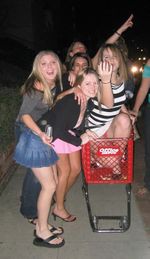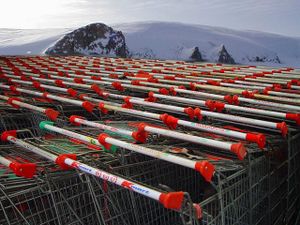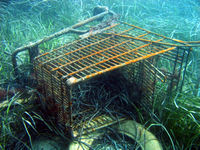Shopping Cart
- This article is about the life-form. For the virtual security(ish) thingie, see Cart. For the British variant, see Trolley.
The term shopping carts refers to a variety of wheeled organisms belonging to the genus cartilaginous which are characterized by the presence of large gridded exoskeleton. The most common of these are cartilaginous grocerius, cartilaginous walmartius, cartilaginous hobousesus, cartilaginous pisspoorus and cartilaginous backleftwheelnoworkii. Though shopping carts are now common in all parts of the industrialized world, wild shopping carts have become nearly extinct, replaced instead by domesticated varieties. Even those carts found roaming free are nearly always domesticated shopping carts gone feral. Sometimes the term is also used to describe a trolley, a similar, related, species.
Biological Characteristics
The social structure of shopping carts is hive-based, with a colony typically consisting of many dozens of "worker" carts and one "queen", whose only purpose is to breed new carts. The only visible sign of difference is that a Queen has an undercarriage that is greatly valued by big game hunters. In the wild, an established colony would also contain several males whose sole purpose is to mate with the queen. In the absence of a male, however, the queen can reproduce clonally through parthenogenesis. This process is only capable of producing workers and these workers lack significant genetic diversity. In order to control the breeding process, most domesticated colonies do not have a male; furthermore most domesticated colonies are formed by simply moving a large number of workers to a new location. In such a situation, one of the workers will become a new queen and a new colony is established. The new colony, however, will be genetically identical to the mother colony.
This overwhelming lack of genetic diversity has been frustrating in recent times, and has lead to numerous missions to seek out and capture wild shopping carts in order to access a greater variety of genetic traits. For instance, when the Target corporation wanted to produce a subspecies of shopping carts with the company's distinctive shade of red, it needed to send out a team of entomologists and adventurers to capture several male carts from the wild.
Overall, domestic carts have grown to be quite different from their wild counterparts in many ways. The wild carts are usually smaller and sleeker, since there is no evolutionary pressure to select for large basket space, and are always much more muscular. Some are also very dangerous! Because of their symbiotic relationship with humans, who wheel them through areas containing food, domestic shopping carts always have little to no muscle mass.
Domestic shopping carts are usually approximately 1.5m long, and 1.3m high, but pygmy variants have been seen. Other variations can be spotted in the form of the wheels and the color and design of the dorsal fin.
Controversies
The use of biological organisms by humans for the purpose of conveying products while shopping has not been without its critics, who argue that the natural place of such creatures is in the wild, not penned-up in urban areas. This argument is somewhat frustrated by the fact that most domestic shopping carts would be unable to survive if released into the wild, since most now lack even basic ambulatory ability, and would easily be killed by their natural predators, like Pamela Anderson, people that suck at driving and often hit shopping carts, Oscar Wilde, and of course dopplegangers. These criticisms usually come from two movements: animal rights organizations and child safety groups. The abandonment of said carts has become an hot topic among many organismic rights groups as well. It may be noted that some Jane Goodall-type poseurs have in certain cases tried to implement themselves into the habitats of said carts and have indeed commandeered said carts for their own uses and exploitation.
PETA
People for the Ethical Treatment of Animals (who have now formed a new branch, People for the Ethical Treatment of Shopping Carts) has been among the most vociferous critics of the practice of keeping shopping carts for human purposes. Most controversially, they have compared the practice to that of human slavery, juxtaposing images of shopping carts huddled together in their parking lot racks with images of slaves chained together in the holds of a slave ship. Unsurprisingly this tactic has been remarkable effective, eliciting great sympathy for the shopping carts and creating solidarity with the black community.
PETA was also active in the Bum-Hobo conflict, a war waged by two groups of destitute and victimized people forced to live on a small piece of crappy land. As the conflict escalated, the Bums began to use shopping carts as weapons by hiding explosives in them underneath their possessions and going to the enemy camp, where they would blow themselves up. Concerned for the shopping carts, PETA issued a statement urging the Bums not to harm any innocent shopping carts when they blew up themselves and others.
Child Safety
Another group which opposes the use of domesticated shopping carts are those concerned for child welfare, who fear that the carts may harm young children. Characterizing the carts as "vicious untamable animals" one group asks, "Why would you put your child into the jaws of such a creature?" Indeed the child seats found on most carts evolved from the same genetic roots as insectoid mandibles, but domestic shopping carts actually take in nourishment by absorbing protein from broken eggs and minerals from trace amounts of automobile paint.
Nevertheless, due to carelessness, neglect, and the simple distance that a child who climbs out from a cart will fall, there were nearly 22,000,000 children injured in shopping cart-related accidents last year. (This figure includes only seat-related injuries; it does not include other cart-related mishaps such as pinchings, scrapings, bumpings, snaggings, foot flattenings, rollovers, and grocer's ear.)
Other Uses For the Shopping Cart
Joyrides
Early on in the history of the domestication of the shopping cart, it was discovered that the cart could be used to convey, not only groceries, but people as well. In the olden days, jealous non-horse owners were known to take "joyrides" on carts, wherein they would run up to an unsuspecting cart, leap onto it from behind, standing on the bar just above the back wheels and holding tight onto the handle, and use their momentum to let the cart carry them across the plains, whooping and hollering. The cart, of course, would do its best to buck the rider, and usually succeeded in the end, by flipping backwards and dumping the joyrider on his head. This has developed into the sport of Shopping Cart racing
The modern shopping cart is often more amenable to being ridden, although ardent cart-rights activists such as PETA insist that this is not a natural and right thing for the cart, whether the cart knows it or not. Unfortunately, the great plains have since been replaced by supermarkets; however, shopping cart-riding enthusiasts point out that the straight, flat aisles of the supermarket make perfect riding strips. They advise placing some weight in the front of the cart's basket to offset the imbalance as one rides. They also advise ignoring other shoppers' strange looks, as this sport often goes unappreciated by non-participants.
Anatomy
The anatomy of a Shopping cart is composed of the following major organs:
- Containa Majora — Large part that stuff goes in
- Containa Minora — Smaller part that stuff goes in
- Reditoris — Red flappy plastic area for inserting children’s legs
- Gravitron — Three working wheels
- Communitron — One noise-making-not-working wheel for conversing within the species
- Cartagina — Reproductive giganto flap
- Handlius — Thing you hold onto to push it
Nomenclature Differences

As with most everyday items, Rhode Islanders have a completely different and arbitrary word for shopping carts. Called "carriages" in the Ocean State, shopping carts have a long history as aids to navigation. The Rhode Island genus of shopping carts (henceforth referred to as carriages) are an aquatic breed, able to withstand the salty brine that is Narragansett Bay. Carriages are trained from birth to help fishermen, lighthouse keepers, coastguard officials and body surfers. The most famous carriage, Stop and Shop was a hero of World War II, destroying no less than 254 of the 321 German U-Boats that patrolled the shores off of Rhode Island. Many people in Rhode Island, however, feel that the carriage Shaw's, whose blood cures Agent Orange poisoning and nearly singlehandedly ended American involvement in the Vietnam War, deserves the greater recognition of valor. So be it.
A few films have been made about the shopping cart but none more in depth than "The Wild and Domestic Shopping Cart" from 1982. It is available on Youtube as the original has been long lost. [1]
See also
- Trolley - A similar species to the Shopping Cart
- HowTo:Drive a shopping cart
- Shopping Cart racing
- Claude Monet


